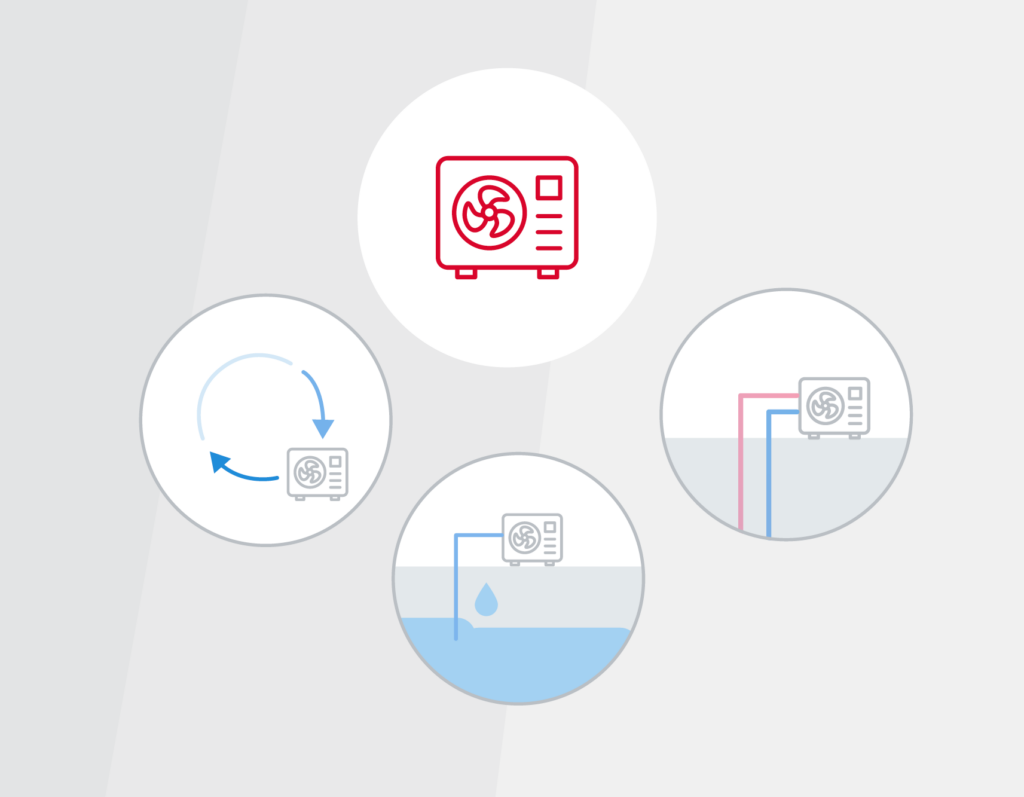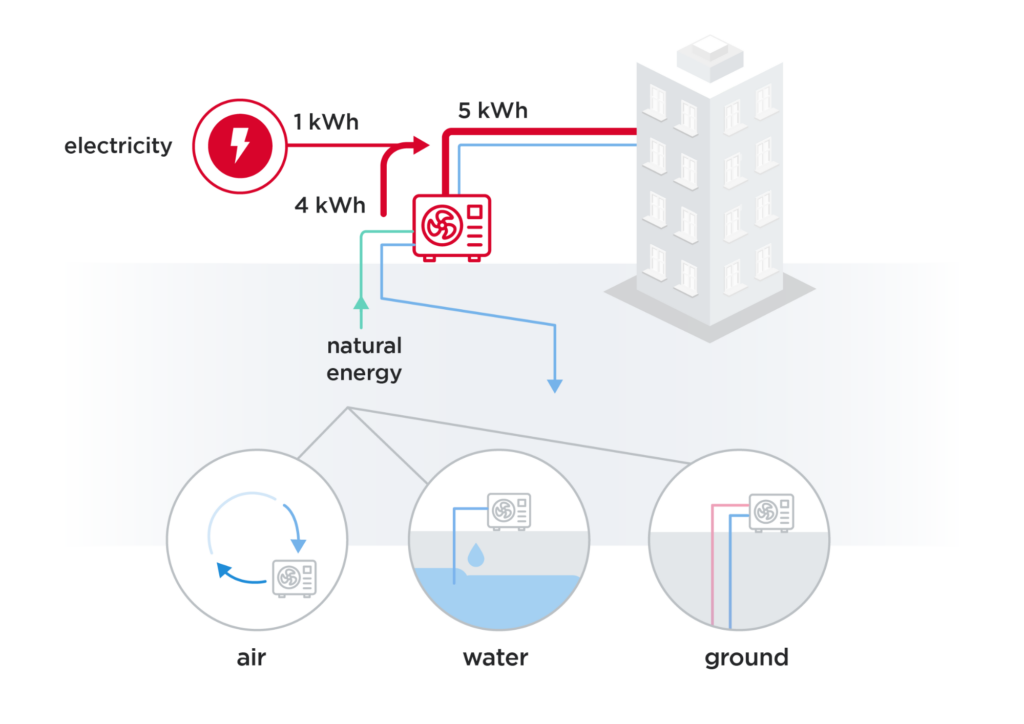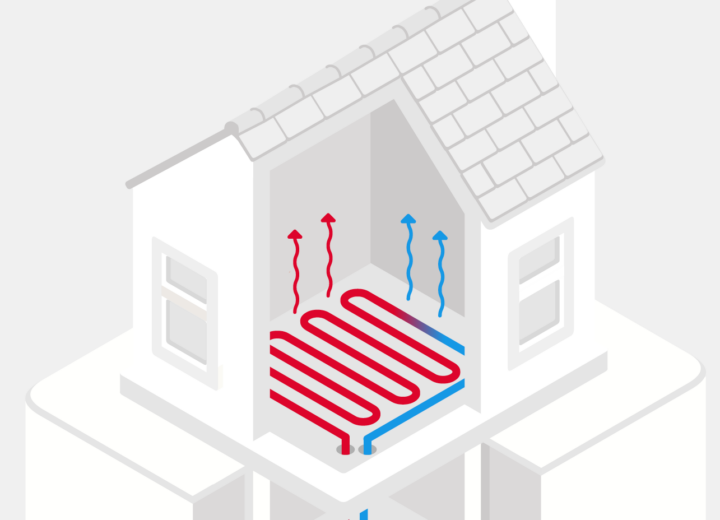Emitters distribute the heat from a heating system around a house or building. Examples include surface heating and cooling (underfloor heating) and radiators. They can be either low or high temperature, heating water to 45°C in a low-temperature system or 60°C – 70°C in a high-temperature system.
Key criteria to consider when choosing an emitter:
- Environmental: Which option is the most sustainable and compatible with all green energies?
- Financial: Which emitter uses less energy and therefore costs less to run?
- Comfort: Which option offers a fast heating time, even heat, no air movement, and reversibility?
Combining underfloor heating with a heat pump can achieve an efficiency of 90% to 110%. Why is this? How does a heat pump work?
NB: This article only deals with heating, domestic hot water is managed by other systems.
How do heat pumps work?
3 heat sources
There are three sources of heat (or cooling):
- Air: recovery of heat calories from ambient air (aerothermal)
- Water: from groundwater, well water or other sources around a building (aquathermal)
- Ground: recovery of heat/cooling from deep underground (geothermal)
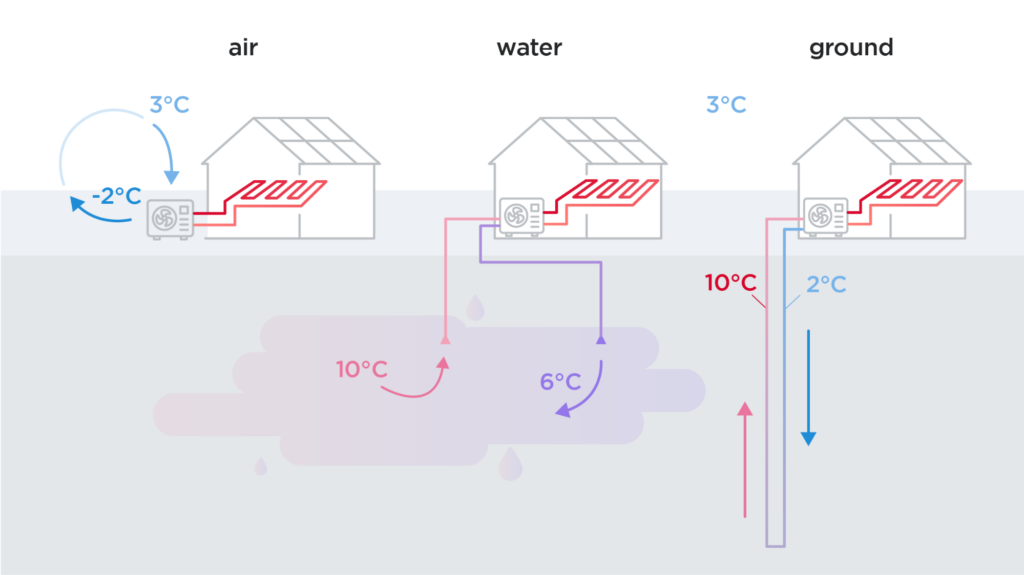
Functioning
There are four main steps in the operation of a heat pump:
1 – Evaporator: heat is extracted from the environment (air, water, or ground)
💡 The hotter the air or water, the better the yield.
2 – Compressor: compresses the refrigerant, i.e. increases the gas pressure of the pump.
3 – Condenser: recovers the calories and feeds them into the heating system.
4 – Expansion valve: returns the liquid to a partially gaseous state, allowing the process to begin again.
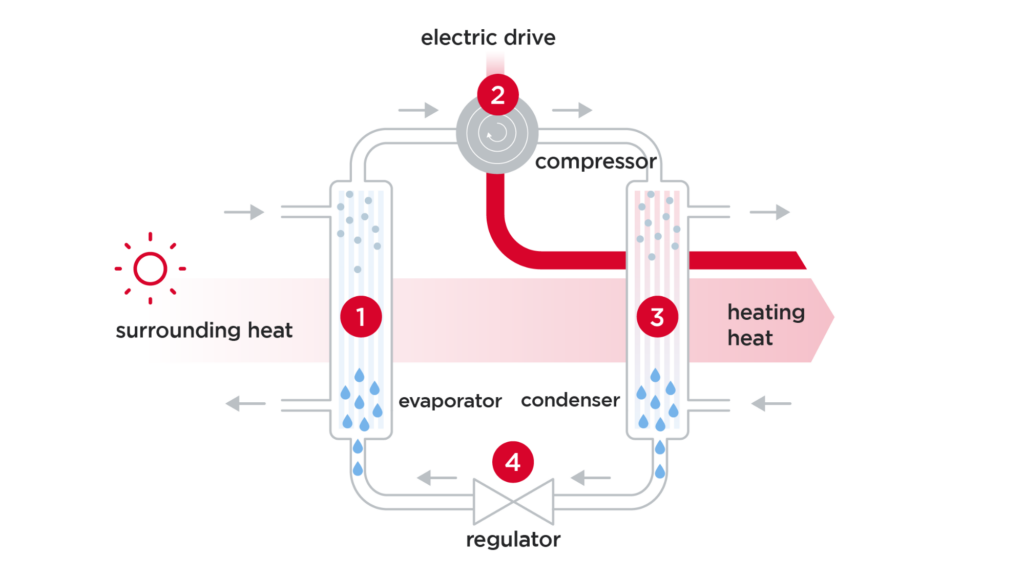
| Refrigerant gas |
| Heat pumps aren’t affected by regulations on refrigerant gases. This is because the gas is trapped in pipes so it doesn’t leak, just like in a fridge. Also, the nature of the gas often changes and becomes more environmentally friendly. |
Determining heat pump efficiency
The efficiency of a heat pump is assessed by its COP (Coefficient Of Performance). This is closely linked to the consumption of the compressor, which is the main component of energy expenditure in a heat pump. The hotter the heat source, the better, so the natural environment must be sufficiently warm.
| Calculating the COP |
| COP = Calorific power returned / Electrical power absorbed For a yield of 5 kWh:
|
The impact of geographical location
The higher the temperature of the outside air, the higher the temperature returned by the heat pump. A warmer environment means that less electrical energy needs to be produced, making the system more efficient and cheaper to run.
That’s why we strongly recommend air-to-water heat pumps in Southern Europe, where there is plenty of heat in the surrounding water and air. Ground source heat pumps are more appropriate in Northern Europe.
In very cold or mountainous regions, heat pumps won’t be able to meet the demand for domestic heating. It’s wise to have a backup solution in these areas, such as a small boiler. This can be integrated into the heating system. For example, the heat pump can pre-heat the water to 50°C, and the boiler can provide additional heat when needed. It’s important to have this in mind during the design phase of the heating system.
Heat pumps and radiant floors
Low-temperature pairing
As a heat pump is a low-temperature source, it must be combined with a low-temperature heat emitter. As long as a radiator is low-temperature, this can be achieved by pairing a heat pump with a radiator.
The best option, with an efficiency between 90% and 110%, is to combine a heat pump with underfloor heating. But how is this efficiency achieved?
Efficiency up to 110%
This type of heating system uses radiation rather than convection. So instead of just changing the temperature of the air, it affects all the people and objects in a room, making it more effective for heating and cooling. It can provide the same feeling of warmth at a room temperature that is 2°C lower. Alternatively, turning down the heating by just 1°C can reduce bills by 7%, giving a total reduction of 15%1.
Underfloor heating is suitable for everything from the tertiary sector to individual homes. It can also be installed as part of a renovation project and works well with high ceilings. And it can work with any energy source, including renewables.
Surface heating and cooling combined with a heat pump offer greater comfort levels, particularly thanks to the absence of air movement. And as its name indicates, it provides cooling, unlike radiators.
Choosing this type of system also means optimising on space. Gain up to 7%2 and use the extra space however you like.
The concealed nature of underfloor heating makes it ideal for use in environments where safety is a concern. There are no exposed elements: this means you can prevent accidents in retirement homes or nurseries. Systems installed in blocks of flats can’t be modified as only the thermostat is visible, reducing unexpected maintenance.
Combining underfloor heating and cooling with a heat pump is the way to go for better energy performance and comfort. But do you need an emitter or a heat source? There are two possible scenarios:
- You already have a heat pump and are looking for a low-temperature emitter. In this case, underfloor heating would be an effective solution.
- Or you already have underfloor heating and cooling, i.e. a low-temperature emitter, so you can simply connect a heat pump to it.
For underfloor heating to work effectively, you also need to make sure you choose the right accessories, such as control units. Then let it do the work for you. Enjoy comfort and energy efficiency all year round.
1 Source: ADEME, Energy Savings / 2 Source: COCHEBAT, Underfloor Heating

